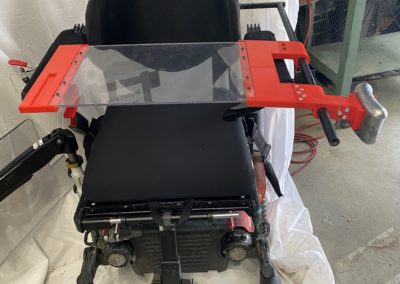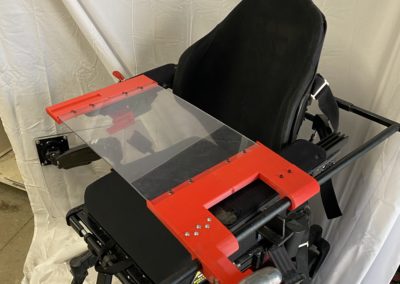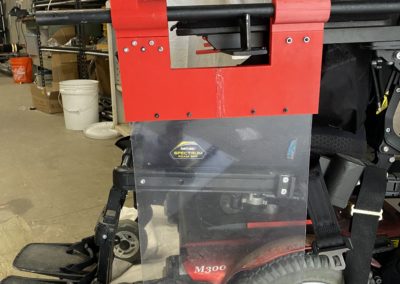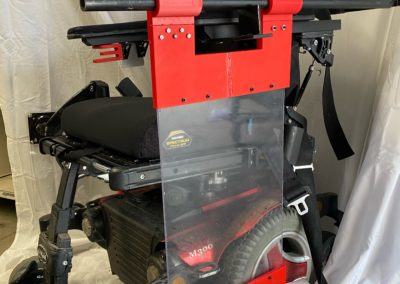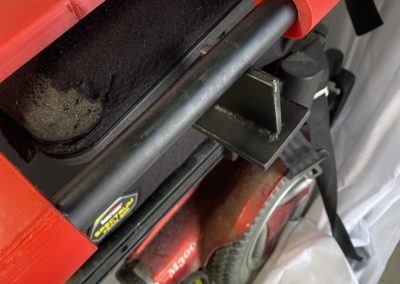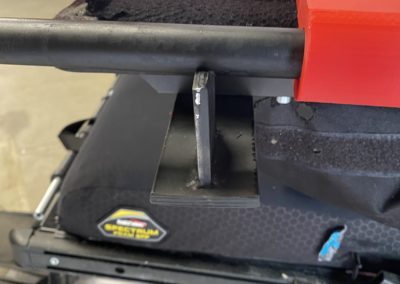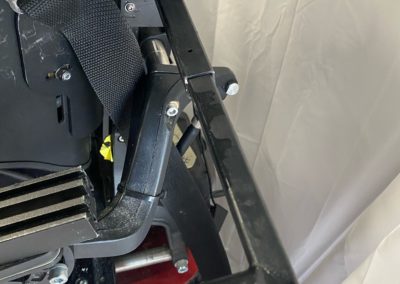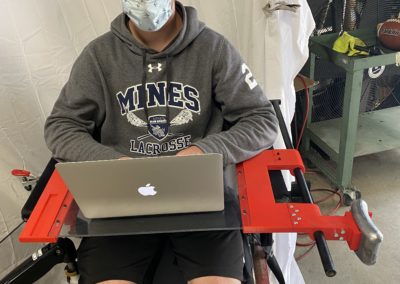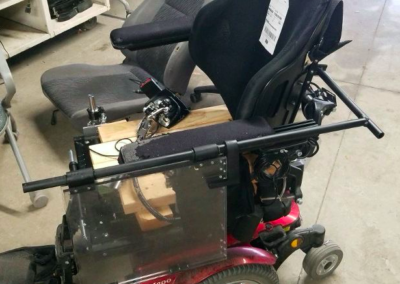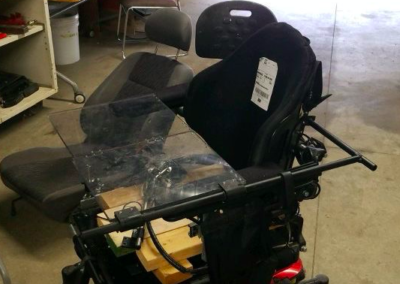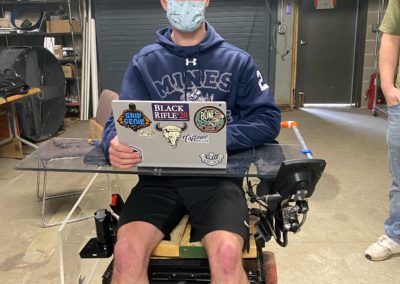Craig Hospital Low Cost Laptray
Overview
Many individuals using motorized wheelchairs may require a specialized semi-permanent working surface in order to perform daily tasks such as computer work, reading, or eating. These surfaces, often called laptrays, replace the function of a traditional table, oriented around this specific use case. However, many laptrays on the market are expensive and heavily inhibit the independence of the user by requiring the aid of a caregiver to set up the laptray, while also burdening the user as no good storage solution promotes portability. Working in conjunction with Craig Hospital, our team created a relatively low-cost laptray centered on user independence while upholding user safety at the forefront of the design.
Our solution (dubbed ‘Swing-Up Laptray’) features a simple design using select materials and geometry, keeping the cost far below competing solutions and enabling users to deploy the laptray independently. The laptray deploys by swinging the tray surface from its resting position at the side of the chair, assisted by a counterweight. To promote the safety of the patient, the tray is transparent to allow the user to see their lower body and quickly removable for transfers or emergencies. Measures have been taken to mitigate foreseeable issues arising from the swinging motion of the tray, such as the counterweight and motion dampeners, ensuring user safety while enabling independence.
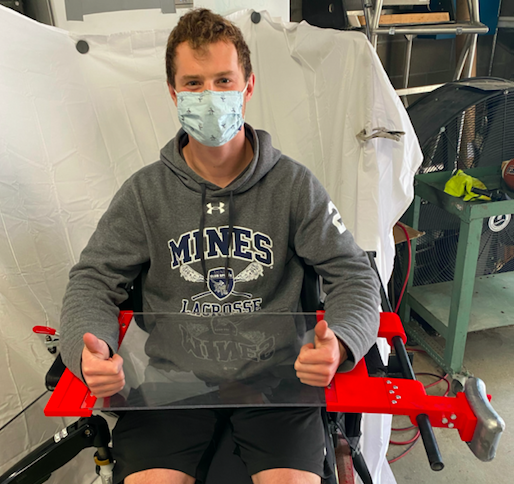
Team Member Modeling Final Laptray Iteration
Live Zoom Chat
Use the link below to join us live from 8:00 – 10:30 a.m. on April 29.
Meeting ID: 967 7218 5490
Team Members
- Tom Simonson
- Beau Baker
- John Baker
- Jared Jensen
- Shayan Mehrani
- Garrett Broussard
The Client
- Craig Hospital
Acknowledgements
Project Advisor: Dr. Kristine Csavina
Technical Advisor: Dr. Steve Geer
Project Client Contact: Patrick Wagner, Rehabilitation Engineer
Project Funding: Craig Hospital
Video
Elevator Pitch
Partial paralysis is a condition that affects many Americans and Craig Hospital is one of the leading rehabilitation centers in the country. As Craig Hospital manufactures their own design of laptrays for their patients they are able to modify and create new designs to better serve the needs of various patients. With the size of many wheelchairs, users struggle to use typical surfaces and for some laptrays provide the only easy to use surface. These laptrays provide patients a surface on which to perform tasks that many people take for granted, such as eating and using technology. This year, our team was tasked with creating a new laptray design to create a new alternative that may suite certain patients better than current designs. This new laptray design’s goal was to promote user independence while keeping costs down for people who may already face hefty medical bills. Many designs on the market are quite cost prohibitive and since they are viewed as an elective feature most insurance companies won’t cover their cost.
Design Approach
The team began design considerations during the fall semester of 2020. Three subgroups were formed to develop three different possible designs to start building. The initial design chosen from the three consisted of an aluminum support arm and bracket attached to a rail mount behind the backrest of the chair that suspends a foldable polycarbonate tray just on the outside of the armrest. The aluminum arm was three pieces of aluminum tubing welded at the joints that was then butt-welded to an aluminum plate that bolts into the chair’s rail. The tray was made up of of two polycarbonate sheets connected in the middle by two cabinet-style hinges. Through the use finite element analysis and rounds of physical testing, it was determined that the two-piece polycarbonate tray deflected too much to be used effectively by the operator and the aluminum support arm and bracket experienced a detrimental amount of torque/loading to the design’s integrity. The design also did not allow for easy removal if the user needed to exit the chair on the side the tray was mounted. To summarize, from this design iteration and build, the key things learned were:
- Rounds tubes promote rotation of the mounting bracket
- Aluminum is too difficult to weld and the reduced weight does not make up for the lack of strength
- The center hinge caused too many problems and added a potential point of failure
- The laptray is too heavy for an end user and was a safety hazard to the the possibility of slamming down during deployment
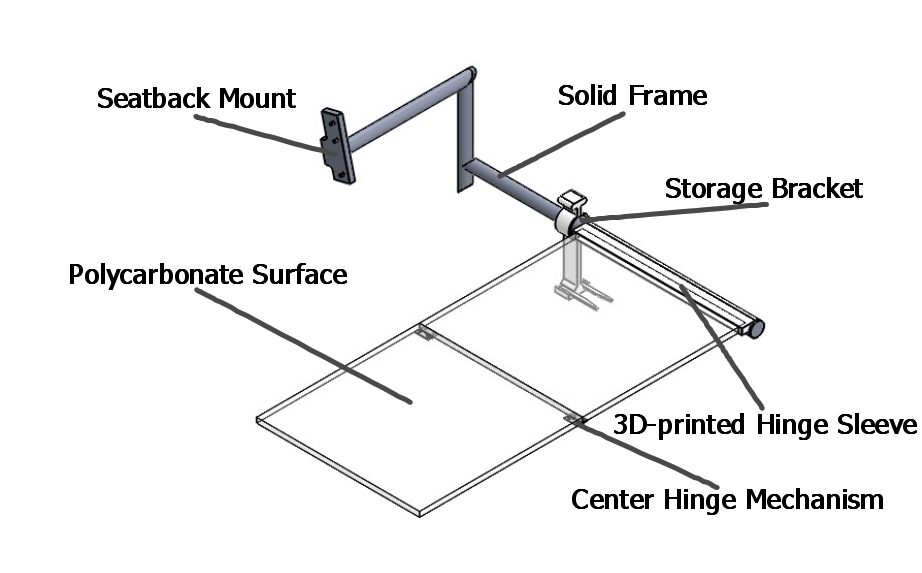
Initial Design with Key Features Labeled
A swift re-design of the prototype, resulting in the final design exchanged the aluminum materials for steel materials in addition to a geometry change of the support arm. Instead of using three circular tubes to create the support arm, two square tubes and a hefty circular tube were used instead. The square tubes are sized differently so the smaller one can slide flush into the larger one. This mechanism was used to make the tray removable where it is mounted on the chair, allowing the user to exit. The tray became one piece of polycarbonate attached to two supplementary pieces of 3D material. An eight-pound counterweight was positioned opposite the tray on the other side of the circular section of the support arm. This allows the user to lift the tray from the stored position to the deployed position with little to no resistance. A supplementary support was also added to the underside of the armrest to support the excess weight from the counterweight mechanism. This allows for smooth gyration around the axis of rotation and increases the life of the materials used for the support arm and bracket.
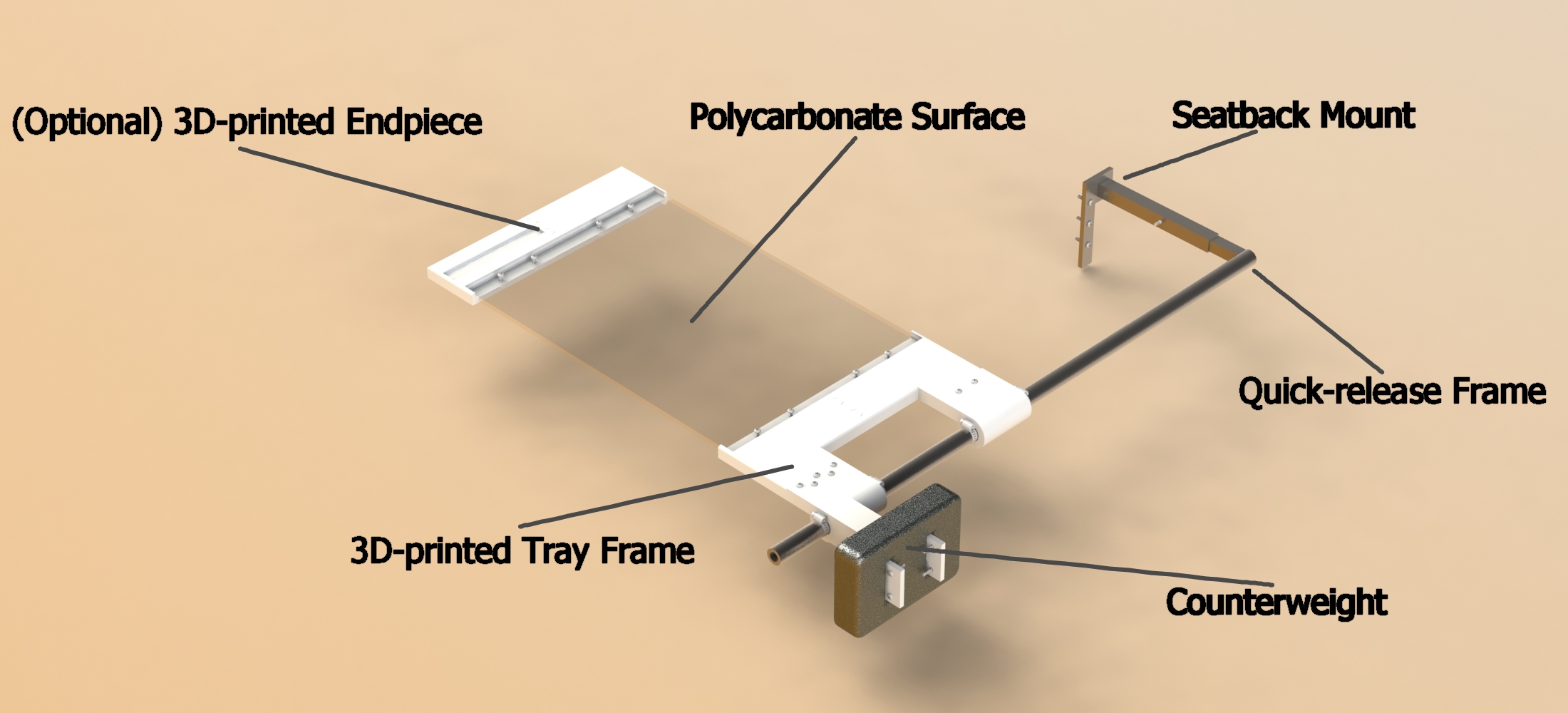
Final Design with Key Features Labeled
Design Solution
Considering the iterations our team moved through during the design process, it is important to consider how the design solution addresses the initial problem statement. See the list below for some of the primary driving goals for our project:
- Develop a solution that costs no more than $300
- Center on user independence and functionality
- Allow the solution to be applicable to a wide variety of powered wheelchairs
- Create a system for storing the solution onboard a powered wheelchair
The main success with our solution centers on the low cost. Similar trays with a less-elegant deployment solution cost upwind of $400, and our team’s final solution comes in at approximately $130 for a single unit. This easily satisfies the cost target outlined by the client and serves the end user by allowing an extremely low-cost solution to enter the market.
Additionally, the final solution iteration features several highly user-friendly features: a quick-release mounting system for transfers to other chairs or surfaces, a counterweight (gravity assist) for easier tray deployment, and a clear tray surface for safe mobility while having a deployed tray. Considering the strength and range of motion is minimal to operate the tray, this design enables user independence while landing at the intersection of cost and functionality. There is minimal adjustment beyond depth tuning, but this reduces cost and improves usability for the end user.
The seatback rail mounting bracket also enables versatility. Essentially, any chair that has a seatback rail would allow this solution to work. The only barrier would be physical clearance, but that is situation dependent.
Moreover, our team’s design meets the project requirements by having a fully onboard storage solution. The tray flips upward from a resting position to the side of the armrest, where it is out of the way of the user. In the event of a transfer being required on the side the tray is mounted, a quick release pin allows caregivers to remove the tray assembly quickly and efficiently. We are ecstatic with the result of our design iterations and where the design solution stands currently and confirm that its features meet or exceed the original project requirements.
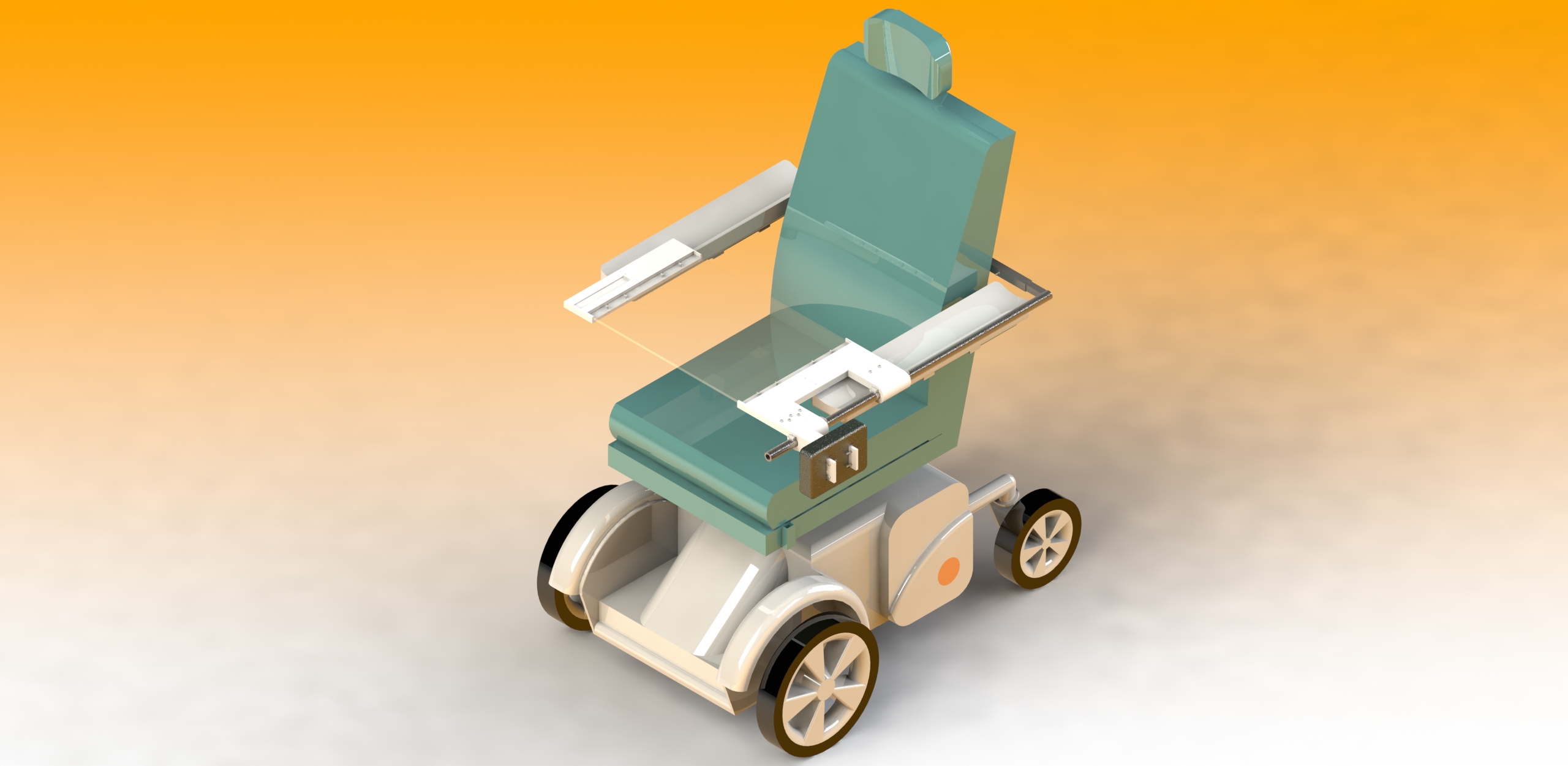
CAD Model of Deployed Laptray
Wheelchair from https://grabcad.com/library/electric-wheelchair-1
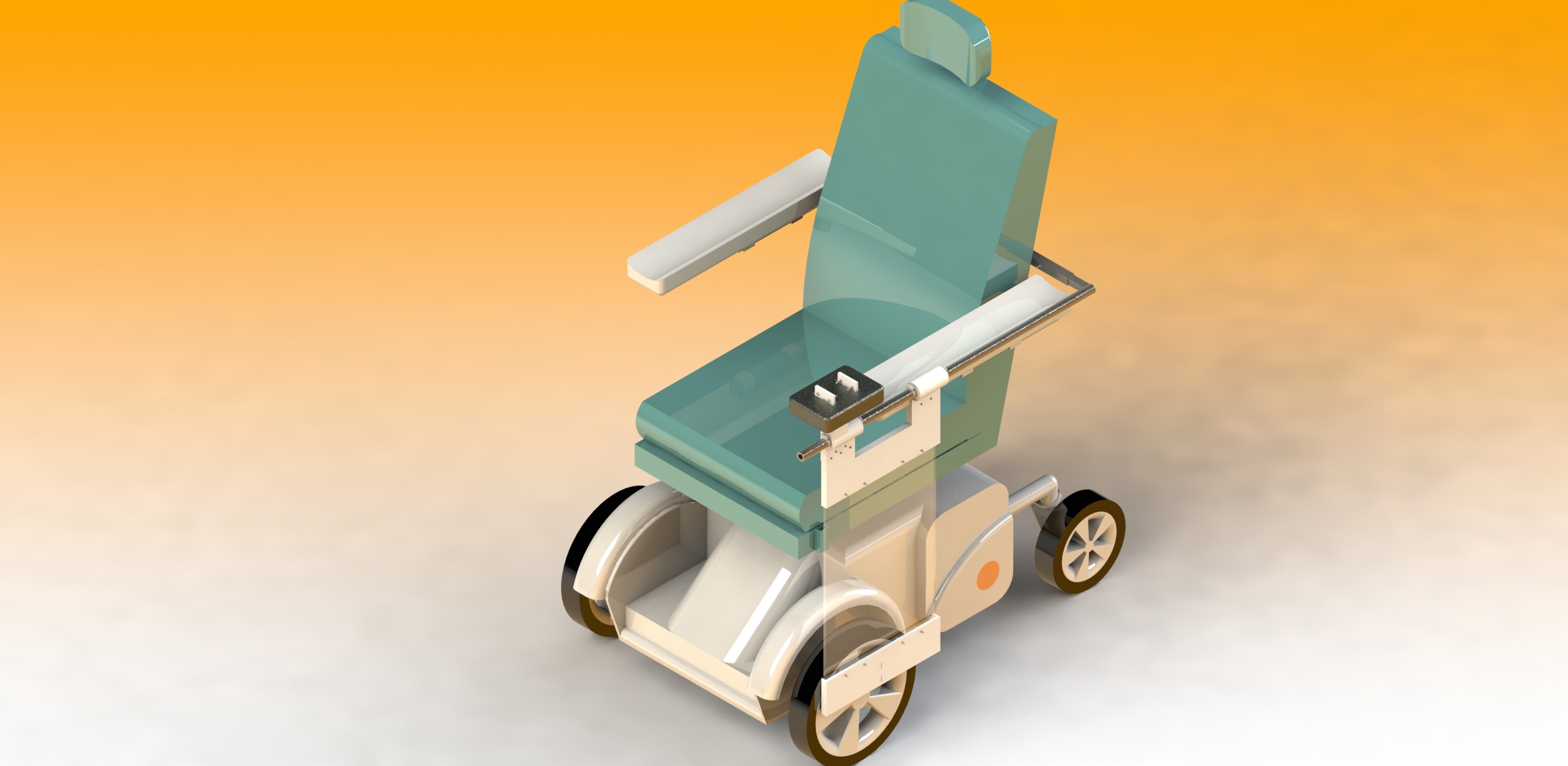
CAD Model of Deployed Laptray
Next Steps
Though a fully functional prototype was developed over the course of the project, there are a variety of improvements that can be made to the current design to increase its functionality and design. During the Final Design Review, the team discussed many possible next steps with our client.
First, refining the surface’s geometry to remove changes in height due to 3D printed parts meeting polycarbonate and to allow a cutout for easier chair control access. Another step that should be taken to improve the project is to change the mounting system for the tray. This would remove the long mounting arm, and moment it creates, in favor of an under-seat mount, similar to those currently used at Craig Hospital. The team also would like to provide adjustable 3D printing files (.stl files) of our components so the client can make small adjustments if the need arises based on patient circumstances or other factors. A final step to take before user testing would be investigating the possible removal of the counterweight and instead using torsion springs to keep the same assisted raising and lowering principles, while streamlining the design.
After these next steps have been investigated and possibly implemented, user testing would need to be performed to identify any potential issues and receive feedback on the design that could provide motivation for improvements in future iterations. Due to restrictions and health concerns related to the ongoing COVID-19 pandemic the group was not able to perform any end user testing.
Meet the Team
Tom Simonson
 Tom Simonson is graduating this May from the Colorado School of Mines with a degree in mechanical engineering and a minor in economics. He is originally from Blair, Nebraska. During the project he served as the communications lead and consulted with many of the manufacturing an design efforts. After graduating he will be pursuing his law degree at the University of Nebraska.
Tom Simonson is graduating this May from the Colorado School of Mines with a degree in mechanical engineering and a minor in economics. He is originally from Blair, Nebraska. During the project he served as the communications lead and consulted with many of the manufacturing an design efforts. After graduating he will be pursuing his law degree at the University of Nebraska.
Beau Baker

Beau is a senior undergraduate student studying mechanical engineering at the Colorado School of Mines. His interests include 3D printing, road trips, and creating and playing video games. Beau joined the Craig Hospital team to innovate and ideate novel solutions for meaningful real-world problems that affect many everyday people.
John Baker
 John is a graduating senior in the Mechanical Engineering Department at the Colorado School of Mines. He is originally from Fresno, California and will be moving to Morenci, Arizona to work in the mining industry at Freeport-McMoRan. Within the team John acted as the financial lead and was in charge of keeping a budget as well as purchasing materials.
John is a graduating senior in the Mechanical Engineering Department at the Colorado School of Mines. He is originally from Fresno, California and will be moving to Morenci, Arizona to work in the mining industry at Freeport-McMoRan. Within the team John acted as the financial lead and was in charge of keeping a budget as well as purchasing materials.
Jared Jensen
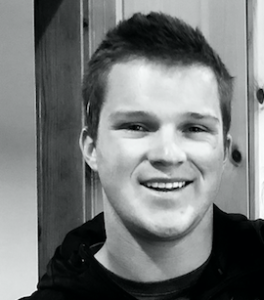 Jared is a senior graduating with a degree in mechanical engineering and an emphasis in aerospace applications. He served as the research lead and performed prototype design verification with finite element analysis simulations. His hobbies include snowboarding, wakeboarding, and hunting. Following graduation, Jared hopes to pursue a career in the aerospace industry.
Jared is a senior graduating with a degree in mechanical engineering and an emphasis in aerospace applications. He served as the research lead and performed prototype design verification with finite element analysis simulations. His hobbies include snowboarding, wakeboarding, and hunting. Following graduation, Jared hopes to pursue a career in the aerospace industry.
Shayan Mehrani
 Shayan Mehrani is a graduating senior studying mechanical engineering. After graduating this May Shayan looks forward to working in the oil and gas midstream industry. Shayan’s favorite part of the senior design project was the fabrication and testing of the product.
Shayan Mehrani is a graduating senior studying mechanical engineering. After graduating this May Shayan looks forward to working in the oil and gas midstream industry. Shayan’s favorite part of the senior design project was the fabrication and testing of the product.
Garrett Broussard
 Garrett Broussard is originally from Houston, Texas and is completing his B.S. in mechanical engineering. On the team he served as the prototyping lead, working to build each design iteration. He loves spending time outdoors and looks forward to putting the skills and knowledge learned at the Colorado School of Mines towards a career in HVAC/Energy Services.
Garrett Broussard is originally from Houston, Texas and is completing his B.S. in mechanical engineering. On the team he served as the prototyping lead, working to build each design iteration. He loves spending time outdoors and looks forward to putting the skills and knowledge learned at the Colorado School of Mines towards a career in HVAC/Energy Services.

